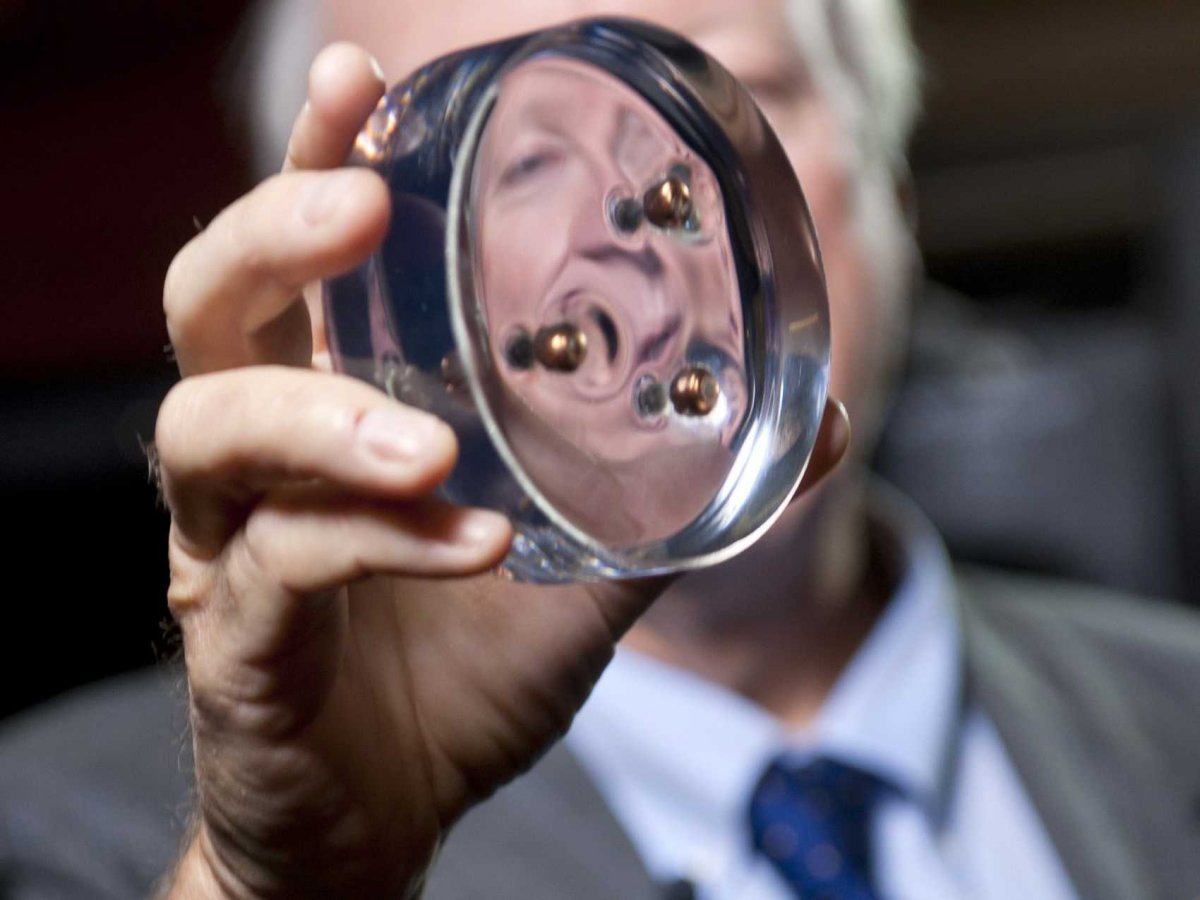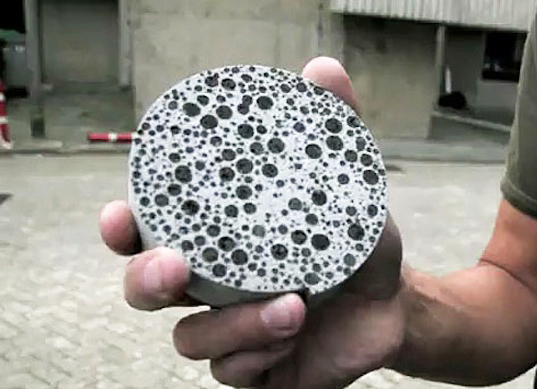Aerographite
Aerographite was created in 2012 by researchers at the Hamburg University of Technology. It’s made from networks of small hollow carbon tubes. Aerographite absorbs light rays nearly completely so it turns black in color. This material is really strong but is also very bendable, it can be compressed into a space 95% its normal area and then be pulled back into it’s normal form without any damage. The stress only makes the material stronger.
How could it be used?
The material is able to conduct electricity and withstand a lot of vibration which means that it could be used for airplanes or satellites. Aerographite is 75 times lighter than styrofoam. It could also be used for:
- Electric cars and bikes
- More efficient water and air purification systems
- Lighter batteries
- Aviation
Ultra-thin material stops high-speed objects
What is it?
You can stop a fast moving projectile, like a bullet, with this super-thin material. It was created by researchers at Rice University and MIT. The material is made from alternating glassy and rubber layers that are each 20 nanometers thick. The way it

works is after being pelted with tiny glass beads, the complex polyurethane material dispersing the energy and seals them inside. The material appears as if there was no damage done. Once the bullets are stuck the material melts into a liquid form in order to absorb the energy then quickly hardens to close the entryway.
How could it be used?
Project researcher Ned Thomas said “This would be a great ballistic windshield material.” Other uses researchers have said it can be used for:
- Stronger jet turbine-blades
- Protection for satellites against meteors and other space debris
- Stronger, lighter armor for soldiers and police
Self-healing Concrete
What is it?
Concrete is one of the most popular building materials but it has one fatal flaw, is vulnerable to cracks and damage. Water and chloride from icing salt can seep into fissures and make them larger but this can be really dangerous and not to mention, expensive. Scientists at Delft University in the netherlands developed a material that uses LIVE bacteria mixed into the concrete before it’s even laid out.

How could it be used?
When water gets through the cracks of the self-healing concrete the bacteria activates and produces s component in the limestone that’s called calcite that then fills up the cracks completely. Researchers say that this material can be used for:
- Building foundations
- Sidewalks
- Other architectural structures
- 3 D ग्राफीन
Highlights
- •
3DG/MoS2 has been prepared by a hydrothermal method.
- •
Flower-like MoS2/3DG is used as electrode materials for supercapacitors for the first time.
- •
High specific capacitance and cycling stability are achieved.
Abstract
Flower-like molybdenum disulfide (MoS2) microstructures are synthesized based on three-dimensional graphene (3DG) skeleton via a simple and facile one-step hydrothermal method, aiming at constructing series of novel composite electrode materials of 3DG/MoS2 with high electrochemical performances for supercapacitors. The electrochemical properties of the samples are evaluated by cyclic voltammetry and galvanostatic charge/discharge tests. Specifically, the optimal 3DG/MoS2 composite exhibits remarkable performances with a high specific capacitance of 410 F g−1 at a current density of 1 A g−1 and an excellent cycling stability with ca. 80.3% capacitance retention after 10,000 continuous charge-discharge cycles at a high current density of 2 A g−1, making it adaptive for high-performance supercapacitors. The enhanced electrochemical performances can be ascribed to the combination of 3DG and flower-like MoS2, which provides excellent charge transfer network and electrolyte diffusion channels while effectively prevents the collapse, aggregation and morphology change of active materials during charge-discharge process. The results demonstrate that 3DG/MoS2 composite is one of the attractive electrode materials for supercapacitors.
Light-generating concrete
Ceramic products are important products that reflect multiple uses, and the use of these products has expanded inside and outside architecture, as these products include special uses such as ceilings, floors, and architectural facades. Natural, urban and other functional areas in the urban fabric. This topic has been dealt with from aesthetic or historical angles, or mainly related to interior or aesthetic design, but this research attempts to study ceramic products from the perspective of employing smart materials, where the technological and environmental aspect is activated to reach the best possible performance. With the beginning of the current century, many raw materials appeared the high-performance smart, which has been used in many smart systems in the field of aviation, architectural buildings, the built environment, the automobile industry and submarines, as it has entered into all aspects of our daily lives with what it achieves at the utilitarian, environmental, economic and aesthetic level, in addition to being sustainable. Therefore, this research aims to monitor the general characteristics of using smart materials in designing ceramic products as technical ceramic systems with a technical dimension that are compatible with the environment and the recipient and achieve aesthetic, functional, economic and sustainability aspects. To achieve this goal, the research was divided into three main axes. The first axis dealt with the study of smart materials (the concept and characteristics), while the second axis dealt with the general characteristics of smart materials, and the research ended with the third axis, which dealt with the external and internal applications of smart materials in the design of ceramic products. The research found that the precise properties of smart ceramic materials made it a fertile field for smart applications such as smart nano-ceramic applications, as well as applications in external urban spaces such as the use of self-sensing concrete to detect traffic and the use of environmental smart self-cleaning photoment and smart light-generating concrete, as well as applications in Interior spaces such as smart cup products and modified smart vases with smart responses.
aluminum फोम
The production of foamed aluminum has long been considered difficult to achieve because of problems such as the low foamability of the molten metal, the varying size of the cellular structures, and solidification shrinkage. Researchers have gradually solved these problems and some manufacturers are now producing foamed aluminum by their own methods. Shinko Wire has been manufacturing foamed aluminum under the registered trade name ALPORAS since 1986, using a batch casting process.A room temperature water model and a high temperature molten aluminum system were designed and constructed to investigate the effect of solid particles on the stabilization of foams. The average foam life was used to evaluate the stability of the foam. The effects of particle size, wetability, and concentration of the SiO2 particles were investigated at various gas flow rates in the room temperature system. The results indicated that only SiO2 particles with suitable wetability can stabilize liquid foam. The foam stability increases with decreasing particle size and increasing particle concentration. The effects of melt temperature and SiC particle concentration on aluminum foam stabilization were investigated in the high temperature system. It was found that a critical concentration of SiC particles was necessary for foaming to occur. The foam height increased with increasing concentration of SiC particles. The stability of the foam decreases with increasing temperature. © 1999 Canadian Institute of Mining and Metallurgy. Published by Elsevier Science Ltd. All rights reserved.




कोई टिप्पणी नहीं:
एक टिप्पणी भेजें